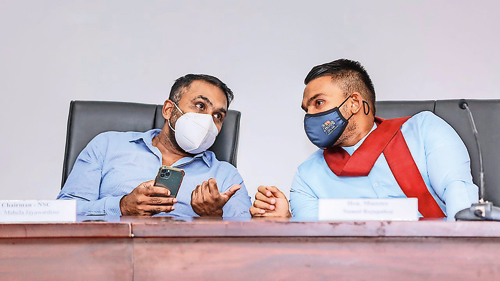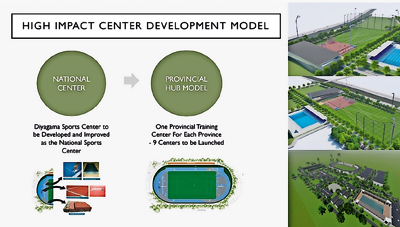NSC unveils plans to make Sri Lanka ‘Sport-ainment’ hub

NSC Chairman Mahela Jayawardene and Sports Minister Namal Rajapaksa having a chat during the press conference
With a comprehensive and long-term plan to develop the background of Sri Lanka’s sports structure, the Mahela Jayawardene-led National Sports Council (NSC) unveiled its plans on Wednesday at the Ministry of Sports auditorium in Colombo.
Among the top priorities of the agenda were the national sports strategy, infrastructure development projects, national high performance strategy, development of sports data centre, creating a development model for high impact centre, spread of sports budget transformation and the national sports calendar, which had an interesting appeal.
The national sports calendar, which has been separated under three key pillars includes the subject of laying a platform for regional sporting events. But the two striking elements are of ‘sport-ainment’ and making Sri Lanka a leisure sports hub, an important segment of NSC’s long-term development project.
What makes the ‘sport-ainment’ more appealing is the fact that it has the potential of easily making Sri Lanka a hub for leisure sports in addition to being a global venue of main sports. Listed among the ‘sport-ainment roadmap’ are a mixture of franchise events as well as other sports activities and events, that could become a major impact and boom in sports tourism.
The franchise-based events that has earned the eye of Ministry of Sports include a Super Ceylon Soccer League, which is ongoing as the FFSL Super League, a Kabaddi League, a Rugby 7s International, the Lanka Premier League (LPL) and Franchise Leagues for Beach Volleyball and Beach Netball. All these five sports earmarked franchised sports leagues are compulsorily expected to include leading athletes from the Asian region and the global arena. Timeframes for these events will be finalised upon confirmation.
 In addition a leg of the Surfing World Series, which usually takes place in Arugam Bay, the Tour De Ceylon and Colombo Marathon are identified as international sporting events, where local athletes could make use to gain exposure. Among other potential sports that could be promoted in this segment are mountain biking, hiking, horse racing and wind surfing, according to experts.
In addition a leg of the Surfing World Series, which usually takes place in Arugam Bay, the Tour De Ceylon and Colombo Marathon are identified as international sporting events, where local athletes could make use to gain exposure. Among other potential sports that could be promoted in this segment are mountain biking, hiking, horse racing and wind surfing, according to experts.
Through this the NSC has proposed to the Ministry of Sports to conduct one sport activity monthly while gaining returns from high impact media rights.
“The focus should be on one mega ‘sport-ainment’ event per month to host and drive engagement and on standardising and gaining maximum benefits from media rights in reach, exposure and commercial benefits,” the NSC report explained.
Though the attraction and entertainment part of sports earn a fair portion of NSC’s attempt in building Sri Lanka’s image as a leading nation in sports, the high-profile council is dead serious in its strategy in developing sports and athletes. The NSC has identified four key strategic pillars — Leisure Sports, Competitive Sports, Sports Economy and E-Sports — as key areas that could define the future of Sri Lanka.
To begin with, the NSC has proposed a revision in the annual budget of the Ministry of Youth Affairs and Sports, which had a share of 54 percent for recurring expenditure, a 40 percent on infrastructure development and a meagre 6 percent dedicated to talent development. From 2021 the budget will be amended as 48 percent for infrastructure development, 32 percent for recurring expenditure and a handsome 20 percent for talent development.
“We have found out that infrastructure is important, but at the same time people development and high performance are key areas that we should really focus on. We have identified four key pillars in our recommendations and we need to encourage talent development as well as sports tourism in Sri Lanka. We cannot make radical changes overnight, but going forward we will give more prominence to this area,” Jayawardene told reporters.
The increased allocation of 20 percent from 6 percent, which converts to Rs 2.9 billion in cash on skill development, is a major enhance for athletes of sports that are potential of bringing glory to Sri Lanka at international stage. The NSC has already started to provide a monthly remuneration to athletes based on a grading scale, where athletes and sports have been slotted into tiers according to the sport’s current status.
This is implemented with the intention to create a unified approach to high performance sports in Sri Lanka that is based on value. while producing sustainable and improved performances to inspire the nation through more medallists at international level.
 To make the exercise more viable, the NSC has recommended high impact centre development models identified as national centres and provincial hubs. Accordingly the Diyagama Sports Centre will be developed and improved as a national centre, while each of nine provinces will be provided with training centres.
To make the exercise more viable, the NSC has recommended high impact centre development models identified as national centres and provincial hubs. Accordingly the Diyagama Sports Centre will be developed and improved as a national centre, while each of nine provinces will be provided with training centres.
“We will not waste the infrastructure that are already available. We will develop them and integrate them to this project, to minimise cost and expenditure on infrastructural development,” Jayawardene added.
At present over 40 infrastructure projects are ongoing which includes four national complexes, 12 district complexes, eight school swimming pools and public ground and 22 volleyball courts.
The Ministry of Youth Affairs and Sports upon recommendations by the NSC, has already selected athletes for contractual agreements, where they will receive a monthly remuneration to engage themselves as professional athletes. The NSC will update on the developments and progress of their work plan, which is based on a long term progressive plan to make Sri Lanka a leading nation in sports.



